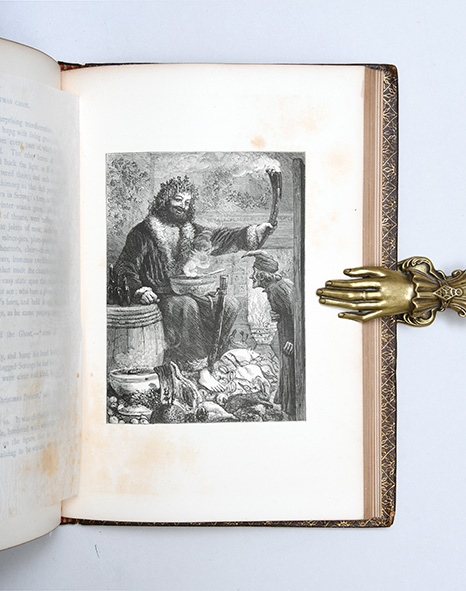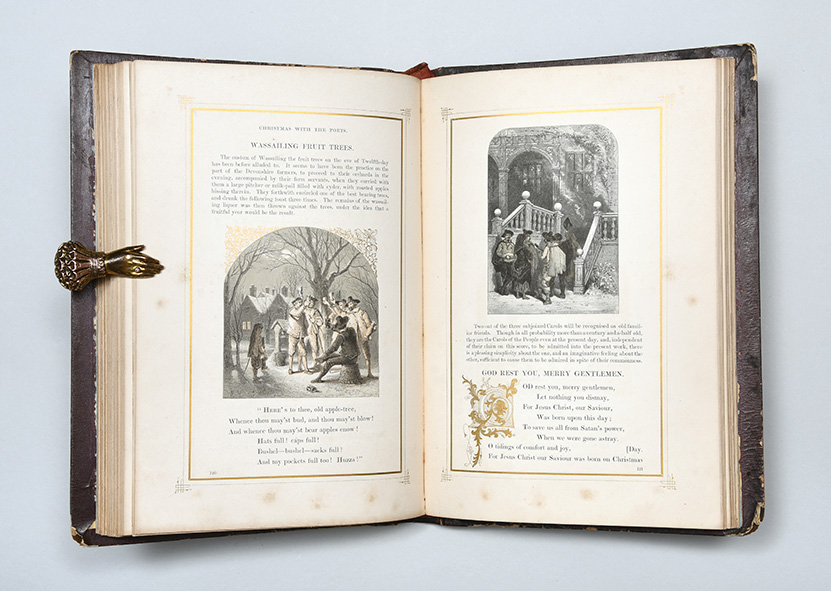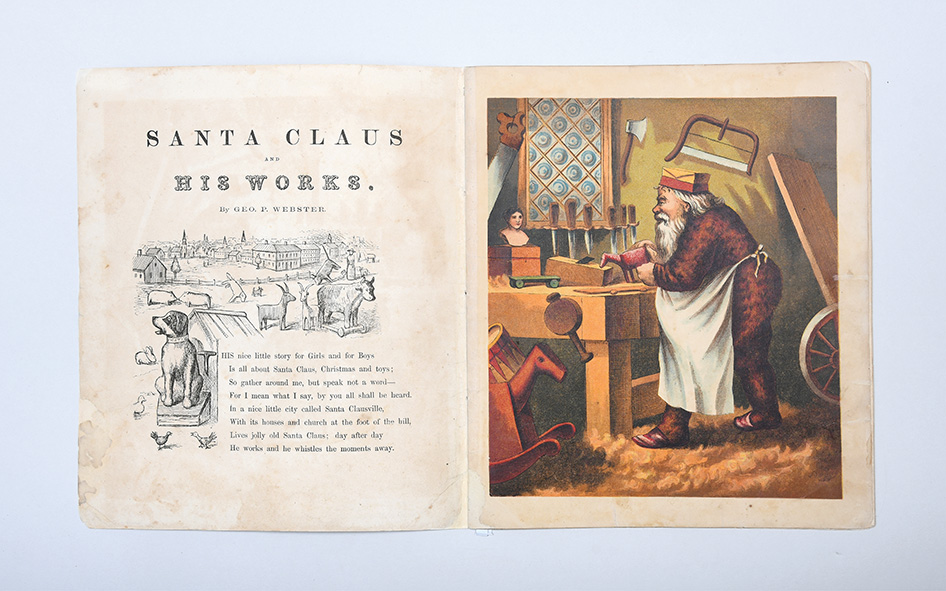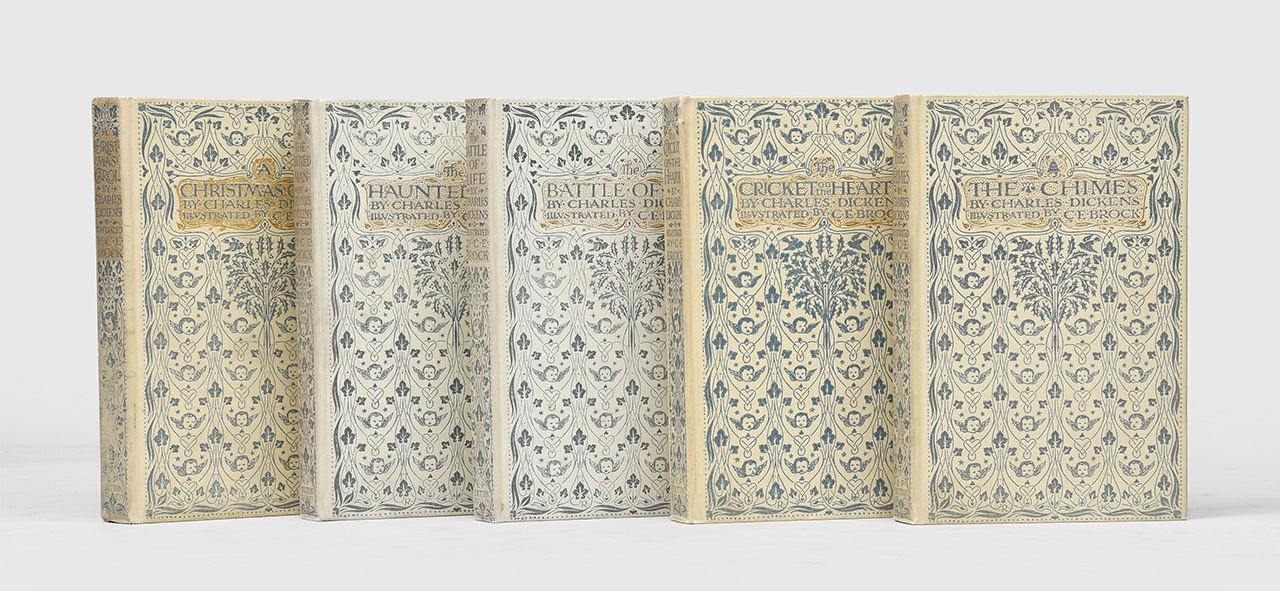“Nothing”, writes Washington Irving, “exercises a more delightful spell over my imagination, than the lingerings of the holiday customs and rural games of former times. They recall the pictures my fancy used to draw in the May morning of life, when as yet I only knew the world through books.” This season has always been an exercise in nostalgia, for any age.
The classics we turn to every December have proved so enduring because they are populated with the ghosts of Christmas past. Our Christmas exhibition spans almost two centuries of festive publishing which have shaped our modern conception of the holiday. While the attraction of these books for readers has always been rooted in the way they speak to cherished traditions, nonetheless each has contributed something new to our celebrations. The printing and reprinting of a set of core texts, reimagining them for each generation, has established a literary mythology for Christmas. The variety on offer displays how both Britain and America have appropriated and adapted each other’s holiday ideals. Through this collection of volumes, ephemera, and original art we can appreciate the foundations of today’s essential customs: from generosity and goodwill, to Santa Claus and cards.
An Emerging Festive Book Market
Any discussion of the festive book market should start with the landmark publication of A Christmas Carol in 1843, which was an instant success in Britain. When Dickens toured the States in the winter of 1867-8, his publishers Ticknor and Fields leapt to capitalise on the immense popularity, releasing little volumes of his readings, and America’s own Christmas Carol in deluxe and trade editions.

The book preached a message that was radical in its rejection of modern values in favour of a return to old-fashioned morality. In his introduction to our facsimile of the first edition, G.K. Chesterton explains that Dickens “saved Christmas”; the “tradition has often been in need of defence, as Dickens here defended it”. But Dickens was not the first to put his pen to resurrecting the true spirit of the holiday. Washington Irving’s work pays tribute to an American admiration for a lost golden age embodied by an old English Christmas, where social harmony and communal cheer presided between classes.
Among our collection are the first volumes of Irving’s Christmas stories to be published separately from the larger works in which they first appeared: The Keeping of Christmas at Bracebridge Hall (1906) and his Old Christmas (1876). The former appeared, fittingly, as part of Dent’s English Idylls series, with illustrations by Charles Edmund Brock, who also illustrated our set of Dickens’s five Christmas books. Brock’s work embodies the spirit of Christmas nostalgia; a connoisseur of Regency and early Victorian design, his ‘period-piece’ watercolours perfectly evoke a lost era.
The Timeless Influence of The Night Before Christmas
If A Christmas Carol is the festive novel par excellence, then The Night Before Christmas is its poetic peer. First published anonymously as “A Visit from St. Nicholas” in the Troy Sentinel in 1823, the poem’s author was first identified when the American scholar Clement Clarke Moore included it in his anthology of poetry in 1844. Its status in the national canon is clear from its inclusion in an American treasury of Christmas Poems and Pictures from 1864.

This anthology features many of the same traditional English verse and carols as our Christmas with the Poets, published in London in 1851, but, crucially, adds Moore’s new classic. Although Moore named his character after the familiar Dutch saint so long associated with the season, his description of the figure was quietly revolutionary: “this Santa had no precedent in history” (Restad, Christmas in America, p. 47). The latter half of the 19th century saw a flurry of illustrated reprints, snowballing into a publishing phenomenon in the States (it arrived in the UK around 1890; one of the earliest foreign editions of the poem is among those on offer this year). The great US cartoonists and illustrators of the day tried their hands at the poem, such as F. O. C. Darley, from whom “American book illustration can be said to have begun” (ANB).
Our 1862 edition of his Visit from St Nicholas is believed to be the first book to print the last line as “Merry Christmas to all”, replacing the original “Happy”. In 1862, Thomas Nast, the “Father of the American cartoon”, first sketched Santa Claus for Harper’s Weekly, inspired by Moore’s “chubby and plump… right jolly old elf”. He continued to draw him for decades, culminating in an anthology of his Christmas drawings published in 1890. Over the years, Nast’s various depictions popularized the image of Santa Claus as we now know him. A particularly early incarnation of his Santa is found in the curious palm-sized Visit from St Nicholas, which unfolds like a concertina, produced in 1864 by Louis Prang. Prang later brought Christmas cards to the American market and this little souvenir anticipates his first cards by over a decade. It depicts Santa wearing a brown fur suit; only later did Nast begin to dress him in the red with which he is now associated. Through the sheer number and range of illustrations from the 19th century we are showing this year, one can watch Santa’s development from a diminutive figure fitting Moore’s elfin description, who is dwarfed by his naughty-and-nice book (believed to be a Nast invention), to an adult-sized one.

One of Nast’s major publishers was McLoughlin Brothers. Founded in 1858, they specialized solely in children’s entertainment, from books to games and toys, which was unusual at the time. John McLoughlin Jr. was a keen innovator in the realm of colour illustration, who experimented with various techniques until McLoughlin Brothers started producing lavish chromolithographs, for which they became renowned; by 1870 they had the largest colour printing factory in the country.
Until John McLoughlin Jr.’s death in 1905, the firm remained the market-leaders despite much new competition in the juvenile sector. Capitalizing on the power of familiar favourite stories, they cannily repackaged content for decades with vibrant lithographs and in various formats: on linen, paper, and thick card. The Night Before Christmas was a natural classic for them to reissue each year, as was a spinoff called Santa Claus and His Works. In December 1865 Nast provided his first major depiction of Santa for Harper’s Weekly, a multi-scene work titled “Santa Claus and His Works”, revealing what Santa did in the off-season. It further elaborated the mythology behind the figure who had emerged from Moore’s poem, such as locating his home on the North Pole. Seeing the commercial potential, in 1869 McLoughlin Brothers contracted Nast to illustrate a book alongside a poem of the same name provided by George P. Webster.
Among the many McLoughlin books we have collected this season, particular highlights are the couple of volumes of Santa Claus and His Works illustrated by Nast, as well as the first and second editions of A Visit from St. Nicholas for which he was commissioned by the McLoughlin. While the majority of their books are illustrated anonymously by in-house artists, the publishers were quick to name those illustrators, such as Nast, who were known to the public. But it was the McLoughlin brand itself which became most familiar with their young consumers, and which became so closely associated with the image of the favoured national saint, Santa Claus.
Festive Illustrations
To conclude our whirl-wind tour, one must appreciate the continued reinterpretation of these foundational texts throughout the 20th century, through seminal new illustrations, like those of Arthur Rackham, and eccentric retellings, such as How the Grinch Stole Christmas. Dr Seuss dressed his antihero in the iconic red Santa suit, gave him the temperament of Scrooge, and told a timeless story of redemption, once again in resounding rhyming couplets. It had all the trimmings one expected of a seasonal classic, but added an important reminder: that the materialism that had sprung up around the holiday was not, really, at its heart. “Maybe Christmas… perhaps… means a little bit more!”





